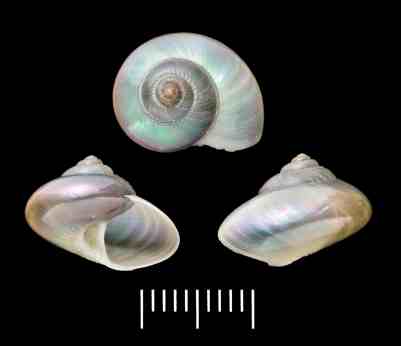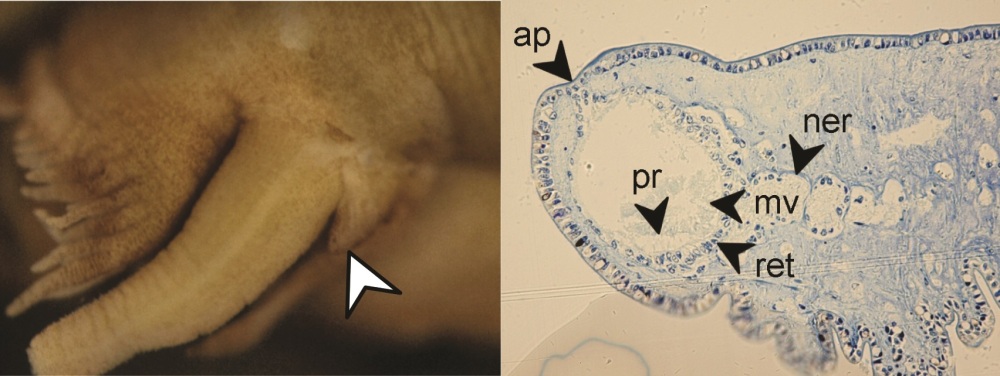This week’s post is from Lauren Sumner-Rooney, a post-doctoral researcher at the Museum für Naturkunde. If you would like to write for Anatomy to You, get in touch via Facebook or Twitter.
The featured image shows a specimen of a new species of Zetela (a snail), removed from its shell. Image: Natural History Museum, Specimen: Museum National d’Histoire Naturelle, Paris.
We’ve all seen images of the weird and sometimes nightmare-ish creatures that dwell in the ocean depths. One of the features that appears time and time again in these animals – as well as their creepy cave-dwelling counterparts – is the lack of eyes. Blindness is very common in animals that live in the dark (even in burrowing species like moles), but how does it actually evolve? It may seem counterintuitive that the fittest individuals in an ancient population were those less able to see, but eyes are often complex and energetically expensive, and making a saving in a dark habitat could leave more energy for other important activities.
One of my greatest interests lies in how this eye loss arises over time. In work published a few months ago, I used a little-known family of marine snails to study when, how and maybe why some species lost their eyes. Solariellid snails are found all over the world, from the shallow seas to the darkest depths. This made them an excellent ‘natural experiment’, with many different groups independently moving into deep water and becoming blind acting as replicates under reasonably similar conditions.

From looking at 67 different species, it was clear that this phenomenon was widespread in the family. I picked nine species to look at more closely, and used a technique called serial sectioning to reveal the structure of their eyes. Each snail was embedded in plastic and cut into thin slices (just 1.5 μm or 0.0015 mm thick), so that individual cell layers could be seen under the microscope. The sections were photographed and used to painstakingly reconstruct digital 3D models of the eyes with a high level of detail.
It became apparent that eye loss was even more common than we’d thought – even eyes that looked normal at first glance were hiding degenerated lenses, eyes sunken beneath the skin or other features not visible from the outside. Even those which appeared to completely lack eyes surprised us: in these cases, the eye was very much still present, but was rendered invisible from the outside by the loss of its retinal pigmentation.

Struck by this diversity of eye degenerations, we coded the various features (pupil

presence, eye size, pigmentation, etc.) and used ancestral reconstruction software methods to work out where in the solariellid family tree they might have appeared, and in what order. To our surprise, we found that contrary to common belief, the process of eye loss showed a lot of variability! Instead of a successive or predictable process, we found that while one group might lose its pigmentation before any other features, another had intact eyes which were simply sunken beneath the skin. This conflicts with the concept that there are developmental keys to the evolution of eye loss, which have been found (and are real!) in smaller groups such as cave fishes, where similar causes of blindness have been found in multiple lineages.
What might this tell us about how eye loss evolves more broadly? Several studies in the last decades have shown that selective pressure plays a part, actively ‘promoting’ eye loss in order to save energetically. But the different evolutionary trajectories taken by different groups of solariellids show that there is a lot of room for flexibility in how this process takes place. This suggests that there is a considerable role for genetic drift – mutations arising at random in the absence of selective pressure – despite the fact that eye evolution is often thought to be quite constrained by other developmental processes. The interplay between these two evolutionary forces remains an intriguing subject, but these tiny animals have given us a snail’s eye view of life in the dark.
You can read the full paper here. This work has been published as:
Sumner-Rooney, L. H., J. D. Sigwart, L. Smith, J. McAfee, and S. T. Williams. 2016. Repeated eye reduction events reveal multiple pathways to degeneration in a family of marine snails. Evolution. 70:2268–2295.